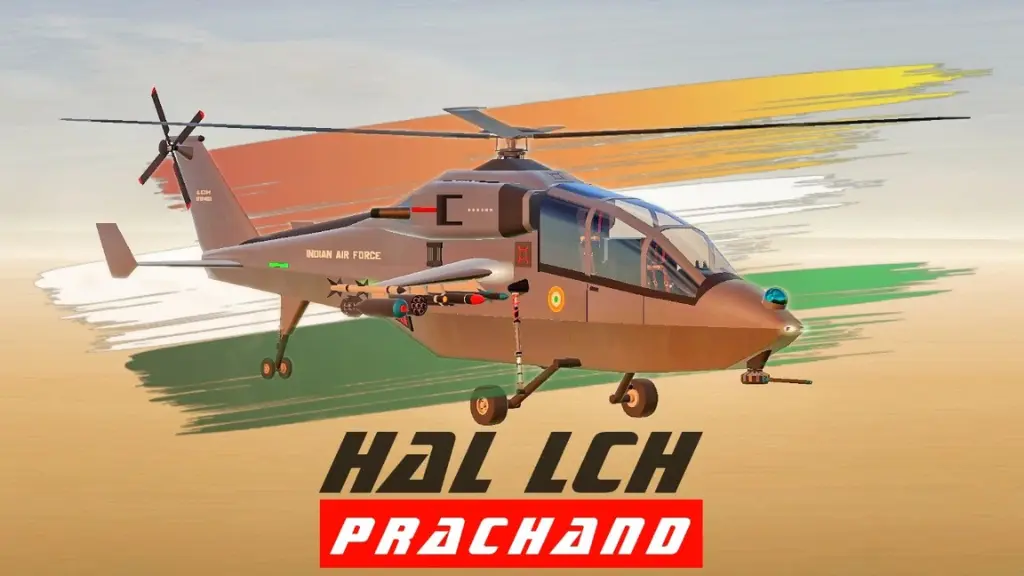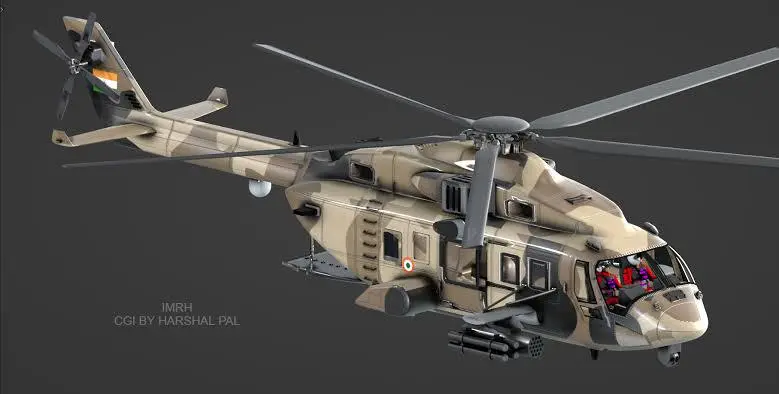India’s defence industry has entered a transformative phase with the development of the Indian Multi-Role Helicopter (IMRH), a groundbreaking addition to the Indian Armed Forces. Designed by Hindustan Aeronautics Limited (HAL), the IMRH promises to enhance India’s operational flexibility. It provides advanced multi-role capabilities, significantly boosting air assault and logistical operations.
This helicopter is more than just a multi-functional platform; it sets the stage for India’s self-reliance in aviation, combining both technological sophistication and indigenous design. It will play a vital role in combat and strengthen India’s strategic defence capabilities.
India’s Bold Leap with the LCH and the IMRH
India’s defence modernization efforts have swiftly accelerated, marked by the recent Light Combat Helicopter (LCH) contract for 156 units. Impressively, the LCH is tailored for close combat support, counter-insurgency, and anti-tank missions. Consequently, these helicopters elevate India’s combat readiness, infusing significant firepower into the Indian Air Force (IAF) and the Army. Looking ahead, this bold move underscores India’s commitment to building a self-reliant and formidable defence infrastructure.
At the same time, the IMRH is poised to follow suit, delivering a versatile solution to replace older platforms like the Mi-17 and Mi-8. With capabilities spanning combat missions to search and rescue, the IMRH will soon play an indispensable role in strengthening India’s defence operations.
Indian Multi-Role Helicopter (IMRH): Powerful Design & Indigenous Capabilities
The IMRH boasts an advanced design, meticulously crafted to meet the demanding needs of the Indian Armed Forces. Let’s look at its essential specifications:
- Max Takeoff Weight (MTOW): 13,000 kg
- Engine: Powered by the Aravali engine, a homegrown turboshaft engine developed by HAL, ensuring complete independence from foreign suppliers.
- Rotor System: Equipped with a five-bladed main rotor and four-bladed tail rotor, the IMRH delivers superior stability, agility, and reduced vibrations for enhanced performance.
- Payload Capacity: The IMRH handles heavy ordnance and cargo, ensuring it can perform both combat and logistical operations.
- Range: Estimated around 500 km
- Max Speed: 275 km/h (approximate)
This combination of indigenous technology and innovative design makes the IMRH a formidable asset for India’s future defence needs.
Indian Multi-Role Helicopter (IMRH) – Powerful Design & Specifications
The (IMRH) is a highly capable, multi-role platform adaptable to a variety of missions. It merges modern technology with indigenous engineering to create a reliable and efficient aircraft, supporting India’s defence needs. Some key specifications include:
- Max Takeoff Weight (MTOW): 13,000 kg
- Engine: Powered by the Aravali engine, designed by DRDO, offering impressive power and endurance.
- Rotor System: A five-bladed main rotor and four-bladed tail rotor ensure enhanced stability and manoeuvrability.
- Payload Capacity: The IMRH can carry heavy ordnance, cargo, and up to 24 soldiers in tactical operations.
- Range: Approximately 500 km
- Speed: Roughly 275 km/h
- Armament: The IMRH can be equipped with advanced weaponry, including missiles and rockets for attack and counter-insurgency missions.
The “Aravalli” Engine: Powering India’s Future Helicopters

HAL and SAFHAL Helicopter Engines Private Limited developed the “Aravalli” engine, a high-power helicopter engine designed for India’s future multi-role helicopters, including the IMRH and the Deck-Based Multi-Role Helicopter (DBMRH).
- Purpose: The Aravalli engine powers HAL’s next-generation 13-ton medium-lift IMRH and the 12.5-ton DBMRH (naval version of the IMRH).
- Partnership: HAL and SAFHAL, a joint venture between Safran Helicopter Engines SAS and HAL, are jointly developing, manufacturing, supplying, and supporting the Aravalli engine.
- Significance: This engine project is central to enhancing India’s self-reliance (Aatmanirbharta) in critical engine technologies for the aerospace and defence sector.
- Future Plans: The Aravalli engine is designed to operate in diverse and challenging environments. Plans are underway to extend its use to civil markets for offshore operations, utility, and VVIP transport, followed by Maintenance, Repair, and Overhaul (MRO) activities.
- HAL’s Role: HAL plays a major role in manufacturing, ensuring a significant portion of engines are produced domestically, strengthening India’s aerospace technology capabilities.
- AeroIndia 2025: The Aravalli engine was unveiled at AeroIndia 2025.
Pricing and Cost Analysis of Indian Multi-Role Helicopter
Although HAL has not disclosed the exact price of the IMRH, we can make some estimations based on similar military platforms. For example:
- The Apache AH-64 (a heavy attack helicopter used by the Indian Army) costs around $35 million per unit.
- The CH-47 Chinook, a heavy-lift helicopter, is priced at about $38 million per unit.
Given the IMRH’s multi-role capabilities, the price for each unit is likely to fall between $25-35 million, depending on the configuration and level of customization for India’s military needs.

Comparison Table: Apache AH-64 vs IMRH and Other Helicopters
| Feature | Apache AH-64 | IMRH | Mi-17 | CH-47 Chinook |
|---|---|---|---|---|
| Role | Heavy Attack | Multi-Role (Transport, Attack, Anti-Submarine) | Utility, Transport | Heavy-Lift Transport |
| Max Takeoff Weight | 10,000 kg | 13,000 kg | 13,000 kg | 22,680 kg |
| Engine | 2 × T700-GE-701C Turboshaft Engines | Aravali Engine (Indigenous) | 2 × TV3-117VM Turboshaft engines | 2 × T55-GA-714A Turboshaft Engines |
| Max Speed | 293 km/h | ~275 km/h (estimated) | 250 km/h | 315 km/h |
| Range | 480 km | ~550 km (estimated) | 460 km | 740 km |
| Armament | 30mm Chain Gun, Hellfire Missiles, Hydra Rockets | Missiles, Rockets, Heavy Ordnance | Various configurations, Rockets | Various configurations, Heavy Lift |
The IMRH represents a monumental leap in India’s defence modernization. Specifically designed to meet the diverse needs of the Indian Armed Forces, the IMRH not only offers multi-role versatility but also integrates cutting-edge indigenous technology. Furthermore, its potential for future upgrades enhances its strategic value. As a result, the IMRH stands out as a critical asset for India’s evolving military operations and long-term defence preparedness.
In a region characterized by complex geopolitical dynamics, the successful development of the IMRH will, therefore, allow India to take full control over its defence needs. Moreover, it eliminates the vulnerability that comes with relying on external suppliers. Consequently, this strategic autonomy strengthens India’s position on the global defence stage.
The IMRH is a crucial step in India’s defence self-reliance initiative. By developing and deploying this helicopter with indigenous technologies, India not only enhances its operational capabilities but also takes a firm stride toward reducing its dependence on foreign imports for military hardware. Moreover, the IMRH symbolizes India’s growing ability to design and produce world-class aviation technologies domestically. Ultimately, it reflects a strategic shift toward long-term autonomy and innovation in the defence sector.
IMRH’s Contribution to India’s Path to Self-Reliance in Defense

This potential for evolution makes the IMRH even more valuable for India’s defence forces—not just for its current role, but for future strategic operations.
HAL has already proven its ability to transform helicopters into specialized platforms. For instance, the Prachand—developed from the ALH Dhruv to serve as an attack helicopter—stands as clear evidence of this capability. Likewise, the IMRH could follow a similar path. Initially, it will be deployed as a multi-role platform; however, HAL could later modify it to carry heavier payloads and integrate advanced avionics. As a result, the IMRH could evolve into a formidable heavy attack helicopter, ready for the most demanding missions.
Indian Multi-Role Helicopter (IMRH): A Heavy Attack Variant in the Future?

The IMRH is poised to fulfil a similar role. Once it achieves full operational capability, the IMRH can be adapted for heavy attack missions, giving India’s defence forces an edge in high-intensity combat scenarios.
As warfare evolves, the need for a heavy attack helicopter becomes even more apparent. These helicopters can carry advanced radar systems, long-range missiles, and heavy ordnance, turning the tide in critical operations. For instance, the Apache AH-64, equipped with cutting-edge radar and firepower systems, is a prime example of such a platform.
The Need for a Heavy Attack Helicopter and IMRH’s Potential
This versatility enables India to execute a wide range of operations without relying on specialized platforms for each task. Moreover, the IMRH’s design allows for future upgrades, enabling it to evolve into a dedicated attack helicopter when needed.
The Indian Multi-Role Helicopter (IMRH) is a game-changer due to its platform flexibility. Its design allows it to serve multiple roles, from combat to anti-submarine warfare, search and rescue, and VIP transport.
Platform Flexibility – IMRH’s Multi-Role Versatility
- AeroIndia 2025: The Aravalli engine was unveiled at AeroIndia 2025.
- HAL’s Role: HAL plays a major role in manufacturing, ensuring a significant portion of engines are produced domestically, strengthening India’s aerospace technology capabilities.
IMRH: Versatility Across Multiple Roles
One of the standout features of the Indian Multi-Role Helicopter (IMRH) is its remarkable versatility. Not only does it excel in one area, but it also seamlessly adapts to multiple missions, thereby making it an essential asset for the Indian Armed Forces. To illustrate, here are some of the primary roles the IMRH is designed to fulfil:
- Combat Operations: Equipped to carry heavy weaponry such as rockets, missiles, and bombs, the IMRH can conduct attack missions and provide close air support in battlefield conditions.
- Search and Rescue (SAR): The IMRH can be deployed for humanitarian missions, including search and rescue, offering critical support in the aftermath of natural disasters.
- Anti-Submarine Warfare: With additional equipment, the IMRH can track enemy submarines using advanced sonar systems and torpedoes.
- Transport and Logistics: The IMRH can carry troops, cargo, and weapons, making it ideal for logistical operations in combat zones.
Conclusion:
The IMRH exemplifies India’s vision of becoming self-reliant in defence technologies, ensuring the nation’s readiness for modern warfare. As it continues to evolve, the IMRH will undoubtedly strengthen India’s position as a regional power with a capable and self-sufficient defence force.
FAQs (Frequently Asked Questions)
- What makes the IMRH a unique addition to India’s defence forces?
The IMRH is a multi-functional platform designed to perform a wide variety of roles, from combat to logistics. Its indigenous technology and advanced features set it apart from existing helicopters. - Will the IMRH evolve into a heavy attack helicopter?
Yes, the IMRH is designed with the flexibility to evolve into a heavy attack helicopter. It could carry advanced weaponry, and heavier payloads, and incorporate cutting-edge avionics for future attack operations. - How does the IMRH compare with other helicopters?
The IMRH stands out with its indigenous Aravali engine and its versatile design that allows it to handle multiple roles, unlike other platforms like the Mi-17 and Apache AH-64. - What is the significance of the IMRH in India’s self-reliance strategy?
The IMRH is a major step toward India’s self-reliance in defence. By developing this helicopter indigenously, India aims to reduce its dependence on foreign imports and enhance its domestic aviation capabilities.

